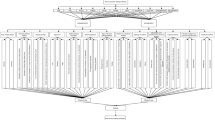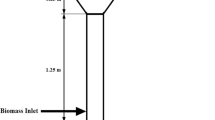Abstract
The objective of this research was to develop a mathematical model for gyratory crushers to help in the prediction of energy consumption and to analyze dominant parameters that affect this energy consumption. The development of a gyratory crusher model was achieved in the following three main stages: mathematical representation and coding of the crushing process; building an amperage constant model to derive an energy-scaling formula; and modifying the amperage constant model to represent a full-scale model. Due to their significant influence on feed-size distributions, two blasting parameters, i.e., burden and spacing, were considered. The crusher parameters that affect energy consumption were also identified. A case study of an operating dolomite mine was performed. The results indicated that by changing the burden, spacing and crusher closed-side setting, the overall (blasting and crushing) costs could be reduced by 4.7% to 7.9% annually. It can also be concluded that burden and spacing values have a linear positive relationship with the crusher energy consumption, while closed-side setting values have an inverse linear relationship with the energy consumption.
Similar content being viewed by others
References
Anderson, J.S., 1988, “Development of a Cone Crusher Model,” M.S. Thesis, University of Queensland (JKMRC), Australia, pp. 5–26.
Anderson, J., and Napier-Munn, T.J., 1988, “Power prediction for cone crushers,” Proc. Third Mill Operators Conference, AusIMM, Cobar, NSW, Australia, pp. 230–275.
Ash, R.L., 1963, “The mechanics of rock breakage: standards for blast design,” Pit and Quarry, Vol. 56, No. 3, pp. 118–122.
Austin, L.G., and Klimpel, R.R., 1964, “Theory of grinding operations,” Ind. Eng. Chem., Vol. 56, pp. 18–29.
Austin, L.G., andBrame, K., 1983, “A comparison of the bond method for sizing wet tumbling mills with a size mass balance simulation model,” Powder Technology Journal, Vol. 34, pp. 261–274.
Awachie, S.E.A., 1983, “Development of Crusher Models Using Laboratory Breakage Data,” Ph.D. Thesis, University of Queensland, JKMRC, Australia, pp. 25–56.
Beke, B., 1964, Principles of Comminution, Maclaren, London.
Bond, F.C., 1952, “The third theory of comminution,” Trans. SME/ AIME, pp. 484–494.
Cunningham, C.V.B., 1983, “Fragmentation estimations and Kuz-Ram model-four years on,” Proceedings of the First Int. Symp. on Hock Fragmentation and Blasting, Sweden, pp. 439–453.
Epstein, B., 1948, “Logarithmico-normal distributions in breakage of solids,” Ind. Eng. Chem., Vol. 40, pp. 2289–2291.
Guillaneau, J.C., Ollofsson, O., Durance, M.V., and Villeneuve, J., 1995, “Modeling of the Sala Agitated mill using BRGMpilotplant data,” Proceedings of XXVAPCOM, pp. 325–331.
Herbst, J.A., and Fuerstenau, D.W., 1968, “The zero order production of fines in comminution and its implications in simulation,” Tran. SME/AIME, Vol. 241, pp. 531–549.
Herbst, J.A., and Fuerstenau, D.W., 1980, “Scale up procedure for continuous grinding mill design using population balance models,” Institute of Mining Proceedings, Vol. 7, pp. 1–31.
Herbst J.A., Chang L.Y., and Flintoff, B., 2003, “Size reduction and liberation,” Principles of Mineral Processing, M.C. Fuerstenau and K.N. Han, eds., SME, Littleton, Colorado, pp. 61–81.
Hukki R.T., 1961, “Proposal forsolomonic settlement between the theories of Von Rittinger, Rick and Bond,” Trans SME/AIME, pp. 403–408.
Hogg, R., 2003, “Particlecharacterization,” Principles of Mineral Processing, M.C. Fuerstenau and K.N. Han, eds., SME, Littleton, Colorado, pp. 9–20.
Inoue, T., and Okaya, K., 1994, “Grinding mechanism in centrifugal mills,” 8th European Symposium on Comminution, Stockholm, pp. 431–440.
Kawatra, S.K, Eisele, T.C., and Wlaqui, H.J., 2001, “Optimization of comminution circuit throughput and product size distribution by simulation and control,” https://doi.org/www.osti.gov/bridge/servlets/purl/837186-Yhbgdr/native/837186.pdf
Kelsall, D.F., Reid, K.J., and Stewart, P.S.B., 1969, “The study of grinding processes by dynamic modeling,” Electronic Engineering Trans. Inst., EE5(1), pp. 84–95.
King, R.P., 1979, “A model for the quantitative estimation of mineral liberation by grinding,” Institute Journal for Mining, pp. 207–220.
Lindquist, M., and Sotkovszki, P., 2003, “Work hardening in cone crusher liners,” <https://doi.org/www.web.sagmilling.nsf/Articles/691 CC7491 F79F1 FA872 56DA8006214DC>.
Lynch, A.J., 1977, Mineral Crushing and Grinding Circuits: Their Simulation, Optimization and Control, Vol. 1, Elsevier, Amsterdam.
Mishra, B.K., and Rajamani, R.K., 1992, “Analysis of media motion in a ball mill,” Comminution: Theory and Practice,” K. Kawatra, ed., SME, Littleton, Colorado, pp. 427–440.
Morrell, S., Napier-Munn, T.J., and Andersen J., 1992, “The Prediction of power draw for comminution machines,” Comminution: Theory and Practice, K. Kawatra, ed., SME, Littleton, Colorado, pp. 405–426.
Mular, A.L., Halbe D.N., and Barrett D.J., 2002, Mineral Processing Plant Design, Practice, and Control, Proceedings, Vol.1, SME, Littleton, pp. 584–600.
Napier- Munn, T.J., Morrell, S., Morrison, R.D., and Kojovic, T., 1996, Mineral Comminution Circuits: Their Operation and Optimization, Vol. 45, JKMRC, Brisbane.
Narayanan, S.S., and Whiten, W.J., 1988, “Determination of comminution characteristics from single particle breakage tests and its application to ball mill scale-up,” Trans of Inst of Min. and Metali, 245, C115–124.
Pothina, R., 2006, “A Gyratory Crusher Model for Energy Savings,” M.S. Thesis, The Pennsylvania State University, University Park, Pennsylvania.
Radziszewski, P., and Tarasiewicz, S., 1989, “Autogenous mill design using comminution energetics,” Proc. Conference on SAG ’89, Vancouver, pp. 773–782.
Rosario, P.P., Hall, R.A., and Maijer, D.M., 2004a, “Improved gyratory crushing operation by the assessment of liner wear and mantle profile redesign,” Minerals Engineering, Vol. 17, No. 11–12, pp. 1083–1092.
Rosario, P.P., Hall, R.A., and Maijer, D.M., 2004b, “Liner wear and performance investigation of primary gyratory crushers,” Minerals Engineering, Vol. 17, No. 11–12, pp. 1241–1254.
Rosario, P.P., and Hall, R.A., 2006, “Integration of gyratory crusher liner wear and operational performance for better crusher management,” CIM Bulletin, Vol. 99 (1095), pp. 1–8.
Svedensten P., and Evertsson V., 2001, Computer assisted optimisation of crushing plants for both machine parameter and wear tolerances, https://doi.org/www.mvs.chalmers.se/≈psvede
ThyssenKrupp, 2005, Gyratory Crushers, <http://www. eprocessingplants.com/eng/html/kreiselbrecher. en.shtml>, pp.1–11.
Vergne, J.D.L, 2005, Hard rock miner’s handbook rules of thumb, <https://doi.org/www.mcintoshengineer-ing.com/Hard%20Rock%20Handbook/hardrock. htm>
U.S. Department of Energ., 2000, “Mineral Processing Technology Road Map,” U.S. Department of Energy, <https://doi.org/www.eere.energy.gov/indus-try/mining/>.
Author information
Authors and Affiliations
Additional information
Paper number MMP-06-058. Discussion of this peer-reviewed and approved paper is invited and must be submitted to SME Publications Dept. prior to Feb. 29, 200S.
Rights and permissions
About this article
Cite this article
Pothina, R., Kecojevic, V., Klima, M.S. et al. Gyratory crusher model and impact parameters related to energy consumption. Mining, Metallurgy & Exploration 24, 170–180 (2007). https://doi.org/10.1007/BF03403212
Received:
Revised:
Accepted:
Published:
Issue Date:
DOI: https://doi.org/10.1007/BF03403212




